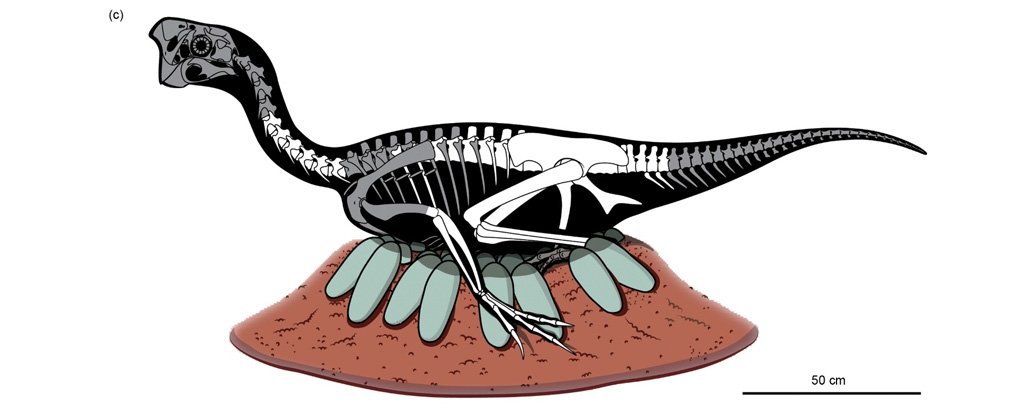
An international team of scientists has announced the discovery of an extraordinary petrified nest in China, which contains at least eight separate dinosaurs from 70 million years ago.
The clutch of old eggs belongs to a medium-sized adult oviraptor, and we know that because the parent is actually part of the fossil. The skeleton of this ostrich-like theropod is crouched over two dozen eggs, at least seven of which were about to hatch and still contain embryos.
The ancient scene is unprecedented and provides the first hard evidence that dinosaurs were breeding parents, laying their eggs and hatching them for quite a long time.
“This kind of discovery – essentially petrified behavior – is the rarest of the rare in dinosaurs,” said paleontologist Matt Lamanna of the Carnegie Museum of Natural History (CMNH).
“Although a few adult oviraptorids have been found on nests of their eggs before, no embryos have ever been found in those eggs.”
 The 70 million year old fossil. (Shundong Bi / Indiana University of Pennsylvania)
The 70 million year old fossil. (Shundong Bi / Indiana University of Pennsylvania)
Since the 1980s, paleontologists have excavated numerous dinosaur nests containing fossilized eggs. Some rare ones have even been found with the skeleton of the parents on it. Other oviraptor eggs suggest they may have been a blue-green color.
However, it has proven problematic to infer behavior from these fossils. While the oviraptor parents may appear to be brooding on their nests, it is also possible that these dinosaurs perished laying or guarding their eggs, not necessarily hatching them. This is more like how crocodiles interact with their nests, not modern birds.
The new specimen was recovered from the Nanxiong Formation of Ganzhou in southern China – a region known for the world’s largest collection of fossilized dinosaur eggs – but it’s unlike anything scientists have found before.
The relationship between dinosaur parent and embryo has never been closer than this. The adult oviraptor’s body is kept “extremely close to the eggs,” with little to no sediment in between.
Embryonic material was exposed in at least seven of the eggs, including fossilized bones in identifiable forms.
One of the eggs may, in fact, contain a complete skeleton, with its vertebrae, back ribs, a humerus, both ilia and femora, and a tibia lying in a curled position.
By analyzing the oxygen isotopes of these embryos, researchers found that the estimated incubation temperature was consistent with the parent’s body temperature, somewhere between 30 and 38 degrees Celsius (86 to 100 degrees Fahrenheit).
“In the new specimen, the babies were almost ready to hatch, which tells us without a doubt that this oviraptoride has been taking care of its nest for a long time,” explains Lamanna.
“This dinosaur was a caring parent who eventually gave his life while nursing his young.”
 Artwork of oviraptor dinosaur incubating on a nest of blue-green eggs. (Zhao Chuang / PNSO)
Artwork of oviraptor dinosaur incubating on a nest of blue-green eggs. (Zhao Chuang / PNSO)
Interestingly, however, not all embryos were in the same developmental stages. This suggests that the link eventually came out at different times – a feature that was thought to show up much later, only in some species of birds.
While oviraptors are often thought of as an intermediate stage in this evolutionary process, it appears that they independently moved away from concomitant hatching, and this suggests that the evolution of avian reproduction was not a simple linear process.
Most modern birds will wait for all of their eggs to be laid before hatching – sometimes with the help of both mother and father – and this leads to synchronous hatching.
While oviraptors may also have waited to incubate until all eggs were laid, the authors suggest that the top eggs may have been closer to the brooding adult and therefore could have developed more quickly. However, this is just an idea. We need more data to find out why some eggs might have hatched before others.
In other ways, however, the oviraptor shares the same traits as modern birds. For example, the sex of the fossilized parent may have been male, suggesting that the father may also have participated in the brooding, similar to ostrich mothers and fathers, who take turns incubating their young.
The sex of the adult oviraptor is still up for debate (it could be male or female based on the available data), but the idea is consistent with other theropod nest analyzes, which suggest some degree of paternal concern.

Artwork of the adult oviraptor skeleton; preserved bones shown in white. (Andrew McAfee / Carnegie Museum of Natural History)
As if all that reproductive information wasn’t enough, this remarkable fossil has also given us a glimpse of the oviraptor’s potential diet. For the first time, scientists have found small stones in the stomach of this type of dinosaur that would likely have been ingested to aid digestion.
“It is extraordinary to consider how much biological information is contained in this one fossil alone,” said paleontologist Xing Xu of the Institute of Vertebrate Paleontology and Paleoanthropology in Beijing.
“We will learn from this specimen for many years to come.”
The study is published in the Science Bulletin